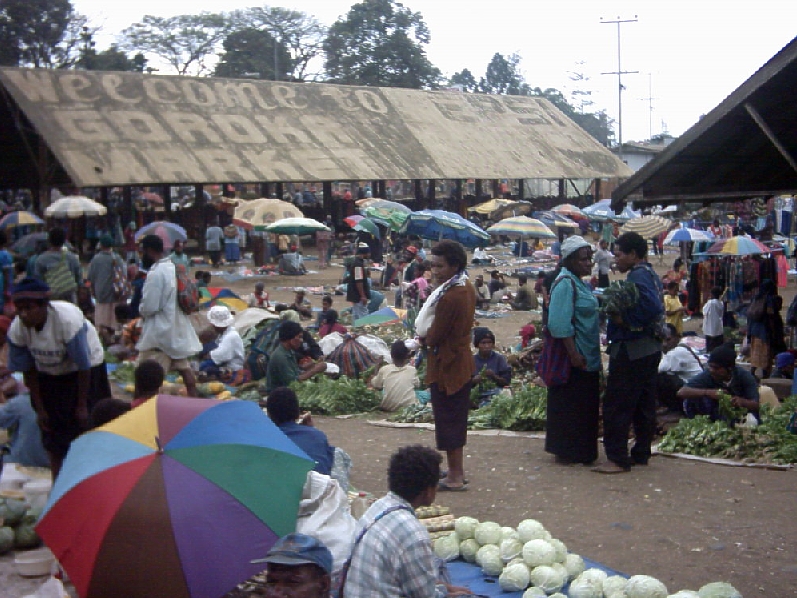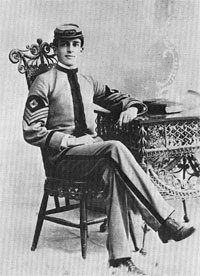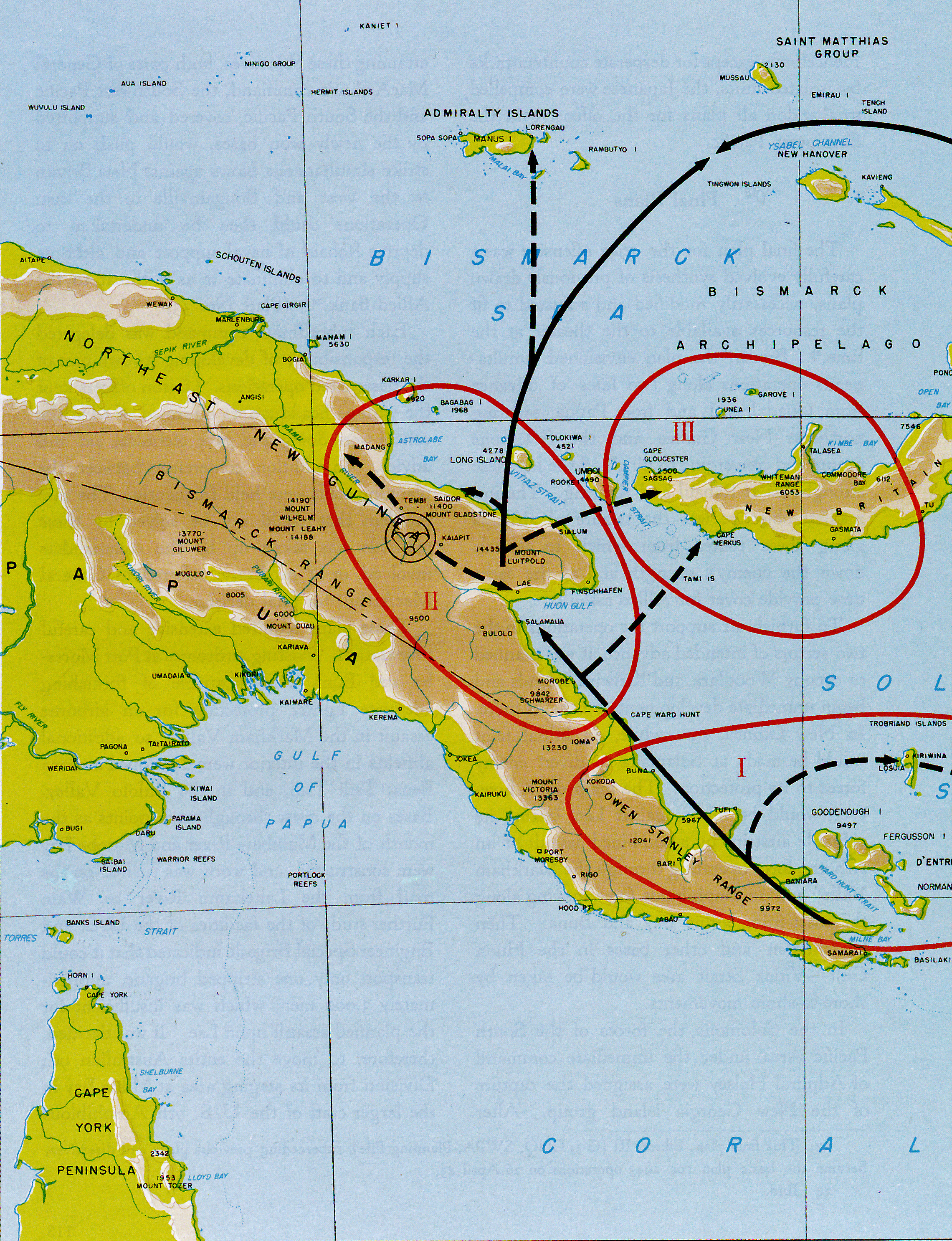|
Battle Of Dumpu
The Battle of Dumpu was an action fought in September and October 1943 between Australian and Japanese forces in New Guinea during the Markham and Ramu Valley – Finisterre Range campaign of World War II. After the Battle of Kaiapit on 20 September 1943, in which the 2/6th Independent Company won a victory against a numerically superior Japanese force, Ivan Dougherty's 21st Infantry Brigade of the 7th Division advanced from Kaiapit to Dumpu in the Ramu Valley. The 21st Infantry Brigade was opposed by Major General Masutaro Nakai's Nakai Detachment, which consisted of the 78th Infantry Regiment and one company of the 80th Infantry Regiment, both from the 20th Division. There was a series of minor actions, but the Australian advance was not delayed, and Dumpu was captured as planned. During the entire advance, the Australian and American forces in the Ramu Valley were supplied by air. The capture of the Ramu Valley allowed a forward airbase to be developed at Gusap. ... [...More Info...] [...Related Items...] OR: [Wikipedia] [Google] [Baidu] |
Markham And Ramu Valley – Finisterre Range Campaign
The Markham Valley, Ramu Valley and Finisterre Range campaigns were a series of battles within the broader New Guinea campaign of World War II. The campaigns began with an Allies of World War II, Allied offensive in the Ramu Valley, from 19 September 1943, and concluded when Allied troops entered Madang on 24 April 1944. During the campaign, Australian forces – supported by Australian and US aircraft – advanced through the Markham Valley and Ramu Valleys during which there were minor clashes with Empire of Japan, Japanese forces, which withdrew towards their main defensive line in the Finisterre Range. A central geographical and strategic feature of these campaigns was the imposing Battle of Shaggy Ridge, Shaggy Ridge, running north–south in the Finisterres; this was the scene of a climactic battle during which the Australians assaulted the Japanese positions in December 1943 and January 1944. Following the fighting around Shaggy Ridge, the Japanese withdrew toward ... [...More Info...] [...Related Items...] OR: [Wikipedia] [Google] [Baidu] |
20th Division (Imperial Japanese Army)
The was an infantry division in the Imperial Japanese Army. Its tsūshōgō code name was the . Formation The 20th Division and the 19th Division were both raised as a garrison force for Korea. After Japan's victory in the Russo-Japanese War of 1904–1905, and subsequent occupation, and then annexation of Korea in 1910, the need was felt for a dedicated garrison force, raised from people with local knowledge. The 20th Division was stationed in central Korea, in what is now Yongsan District, Seoul. The division received its colors on 24 December 1915; however, the division was not considered combat-ready until 1918, and divisional headquarters were co-located with the division only from the 1 April 1919. The delay was due to limited funding available for the division to build its facilities in Korea and the need to recruit and train personnel from mainland Japan. The first commander of the 19th Division was Lieutenant General Tachibana Koichirō. Action After the Mukd ... [...More Info...] [...Related Items...] OR: [Wikipedia] [Google] [Baidu] |
Goroka
Goroka is the capital of the Eastern Highlands Province of Papua New Guinea. It is a town of approximately 19,000 people (2000), above sea level. It has an airport (in the centre of town) and is on the "Highlands Highway", about 285 km from Lae in Morobe province and 90 km from the nearby town of Kainantu also in the Eastern Highlands. Other nearby towns include Kundiawa in Simbu Province and Mount Hagen in Western Highlands Province. It has a mild climate, known as a "perpetual Spring". It is the home of several national institutions: CRMF Christian Radio Missionary Fellowship, the PNG Institute of Medical Research, the National Film Institute, thLiturgical Catechetical Institute the Melanesian Institute, the Raun Raun Theatre Company and the University of Goroka. Several NGOs also have presences there, including Oxfam and Save the Children. The town's single largest hotel is the Bird of Paradise, owned by the Coral Seas Hotels chain. Coffee is a common cash crop in th ... [...More Info...] [...Related Items...] OR: [Wikipedia] [Google] [Baidu] |
Nadzab
Nadzab Village is in the Markham Valley, Morobe Province, Papua New Guinea on the Highlands Highway. Administratively, it is located in Gabsongkeg ward of Wampar Rural LLG. The Nadzab Airport is located East of Nadzab Village and was the site of the only Allied paratrooper assault in New Guinea on 5 September 1943. Location Nadzab is located on the Erap River, North of the Markham River and 42 km North West of Lae. The settlements of Gabmatsung/Gabmatzung and Gabsonkek are located on the East side of the airport. Grasslands The present distribution of grasslands in New Guinea is a product of forest clearance and/or burning by man. Lane-Poole (1925), on surveying the forest of the lower Markham Valley near Yalu, hypothesised that; :''"At one time forest of this type stretched all the way along the coast between the mountains inland and the sea, and all along the vast valleys of the Markham and Ramu Rivers. Today, artificially formed grasslands have taken the p ... [...More Info...] [...Related Items...] OR: [Wikipedia] [Google] [Baidu] |
Operation Cartwheel
Operation Cartwheel (1943–1944) was a major military operation for the Allies in the Pacific theatre of World War II. Cartwheel was an operation aimed at neutralising the major Japanese base at Rabaul. The operation was directed by the Supreme Allied Commander in the South West Pacific Area (SWPA), General Douglas MacArthur, whose forces had advanced along the northeast coast of New Guinea and occupied nearby islands. Allied forces from the South Pacific Area, under Admiral William Halsey, advanced through the Solomon Islands toward Bougainville. The Allied forces involved were from Australia, the Netherlands, New Zealand, the US and various Pacific Islands. Background Japanese forces had captured Rabaul, on New Britain, in the Territory of New Guinea, from Australian forces in February 1942 and turned it into their major forward base in the South Pacific, and the main obstacle in the two Allied theatres. MacArthur formulated a strategic outline, the Elkton Plan, ... [...More Info...] [...Related Items...] OR: [Wikipedia] [Google] [Baidu] |
Douglas MacArthur
Douglas MacArthur (26 January 18805 April 1964) was an American military leader who served as General of the Army for the United States, as well as a field marshal to the Philippine Army. He had served with distinction in World War I, was Chief of Staff of the United States Army during the 1930s, and he played a prominent role in the Pacific theater during World War II. MacArthur was nominated for the Medal of Honor three times, and received it for his service in the Philippines campaign. This made him along with his father Arthur MacArthur Jr. the first father and son to be awarded the medal. He was one of only five men to rise to the rank of General of the Army in the U.S. Army, and the only one conferred the rank of field marshal in the Philippine Army. Raised in a military family in the American Old West, MacArthur was valedictorian at the West Texas Military Academy where he finished high school, and First Captain at the United States Military Academy at Wes ... [...More Info...] [...Related Items...] OR: [Wikipedia] [Google] [Baidu] |
General (United States)
In the United States military, a general is the most senior general-grade officer; it is the highest achievable commissioned officer rank (or echelon) that may be attained in the United States Armed Forces, with exception of the Navy and Coast Guard, which have the equivalent rank of admiral instead. The official and formal insignia of "general" is defined by its four stars (commonly silver and in a row). The rank of general ranks above a three-star lieutenant general and below the special wartime five-star ranks of General of the Army or General of the Air Force. The Marine Corps and Space Force do not have an established grade above general. The pay grade of general is O-10. It is equivalent to the rank of admiral in the other United States uniformed services which use naval ranks. It is abbreviated as GEN in the Army and Gen in the Marine Corps, Air Force, and Space Force. Since the ranks of General of the Army and General of the Air Force are reserved for wartime us ... [...More Info...] [...Related Items...] OR: [Wikipedia] [Google] [Baidu] |
South West Pacific Area (command)
South West Pacific Area (SWPA) was the name given to the Allied supreme military command in the South West Pacific Theatre of World War II. It was one of four major Allied commands in the Pacific War. SWPA included the Philippines, Borneo, the Dutch East Indies (excluding Sumatra), East Timor, Australia, the Territories of Papua and New Guinea, and the western part of the Solomon Islands. It primarily consisted of United States and Australian forces, although Dutch, Filipino, British and other Allied forces also served in the SWPA. General Douglas MacArthur was appointed as the Supreme Commander, Southwest Pacific Area, on its creation on 18 April 1942. He created five subordinate commands: Allied Land Forces, Allied Air Forces, Allied Naval Forces, United States Army Forces in Australia (USAFIA), and the United States Army Forces in the Philippines. The last command disappeared when Corregidor surrendered on 6 May 1942, while USAFIA became the United States Army Serv ... [...More Info...] [...Related Items...] OR: [Wikipedia] [Google] [Baidu] |
George Alan Vasey
Major General George Alan Vasey, (29 March 1895 – 5 March 1945) was an Australian Army officer. He rose to the rank of major general during the Second World War, before being killed in a plane crash near Cairns in 1945. A professional soldier, Vasey graduated from Royal Military College, Duntroon in 1915 and served on the Western Front with the Australian Imperial Force, for which he was awarded the Distinguished Service Order and twice Mentioned in Despatches. For nearly twenty years, Vasey remained in the rank of major, serving on staff posts in Australia and with the Indian Army. Shortly after the outbreak of Second World War in September 1939, Lieutenant General Sir Thomas Blamey appointed Vasey to the staff of the 6th Division. In March 1941, Vasey took command of 19th Infantry Brigade, which he led in the Battle of Greece and Battle of Crete. Returning to Australia in 1942, Vasey was promoted to major general and became Deputy Chief of the General Staff. In Sept ... [...More Info...] [...Related Items...] OR: [Wikipedia] [Google] [Baidu] |
Landing At Nadzab
The Landing at Nadzab was an airborne landing on 5 September 1943 during the New Guinea campaign of World War II in conjunction with the landing at Lae. The Nadzab action began with a parachute drop at Lae Nadzab Airport, combined with an overland force. The parachute drop was carried out by the US Army's 503rd Parachute Infantry Regiment and elements of the Australian Army's 2/4th Field Regiment into Nadzab, New Guinea in the Markham Valley, observed by General Douglas MacArthur, circling overhead in a B-17. The Australian 2/2nd Pioneer Battalion, 2/6th Field Company, and B Company, Papuan Infantry Battalion reached Nadzab after an overland and river trek that same day and began preparing the airfield. The first transport aircraft landed the next morning, but bad weather delayed the Allied build up. Over the next days, the 25th Infantry Brigade of the Australian 7th Division gradually arrived. An air crash at Jackson's Field ultimately caused half the Allied casua ... [...More Info...] [...Related Items...] OR: [Wikipedia] [Google] [Baidu] |
Finisterre Range
The Finisterre Range is a mountain range in north-eastern Papua New Guinea. The highest point is ranked 41st in the world by prominence with an elevation of 4,150 m. Although the range's high point is not named on official maps, the name "Mount Boising" is used locally. This peak was possibly the most prominent unclimbed peak in the world until the first known ascent on 25 June 2014. The range runs into the Saruwaged Range to the east and together they form a natural barrier between the Ramu and Markham valleys to the south and Vitiaz Strait to the north. Many rivers originate in this range, including some tributaries of the Ramu. The Finisterre Range campaign (1943–1944) of World War II, including a series of actions known as Battle of Shaggy Ridge, saw fierce fighting between Australian and Japanese forces. See also * List of highest mountains of New Guinea This list of highest mountains of New Guinea shows all mountains on the island of New Guinea that are at le ... [...More Info...] [...Related Items...] OR: [Wikipedia] [Google] [Baidu] |





.jpg)
